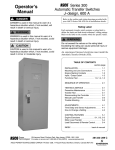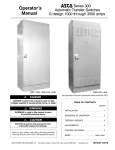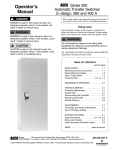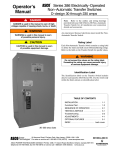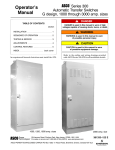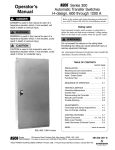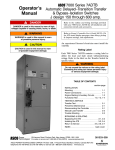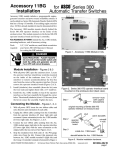Download Emerson 350VA Power Supply User Manual
Transcript
Operator’s Manual Series 200 Automatic Transfer Switching Equipment D–design 30 through 230 amperes DANGER is used in this manual to warn of a hazard situation which, if not avoided, will result in death or serious injury. WARNING is used in this manual to warn of a hazardous situation which, if not avoided, could result in death or serious injury. CAUTION is used in this manual to warn of a hazardous situation which, if not avoided, could result in minor or moderate injury. Note: Refer to the outline and wiring drawings provided with your Series 200 ATSE for all installation and connection details and accessories. Nameplate / rating Label The Series 200 Automatic Transfer Switching Equipment (ATSE) contains a nameplate / rating label which includes data for that specific ATSE. It defines the loads and fault circuit withstand/closing ratings. Refer to the labels on the Transfer Switching device for specific values and use the ATSE only within their limits. An experienced licensed electrician should install the ATSE. Do not exceed the values on the rating label. Exceeding the rating can cause person injury or serious equipment damage. TABLE OF CONTENTS section INSTALLATION . . . . . . . . . . . . . . . . . . . . . . . . . 1 SEQUENCE OF OPERATION . . . . . . . . . . . . 2 TESTING & SERVICE . . . . . . . . . . . . . . . . . . . 3 ADJUSTMENTS . . . . . . . . . . . . . . . . . . . . . . . . 4 CONTROL FEATURES . . . . . . . . . . . . . . . . . . 5 INDEX . . . . . . . . . . . . . . . . . . . . back of manual 50 Hanover Road, Florham Park, New Jersey 07932–1591 USA For sales or service call 1 800 800–2726 (ASCO) www.ascopower.com 381333–234 E A typical Catalog Number is shown below with its elements explained: Catalog Number Identification Typical D–design Series 200 ATS catalog no. for a solid neutral, 3 pole, 100 amp, 400 V, open type: design prefix letter D Neutral A – solid B – switching C – overlapping 200 A Phase Poles 2 – single Ø 3 – three Ø blank – none * 200 & 230 A are limited to 480 volts 3 100 Amperes 30 70 100 150 200 * 230 * J 5X Voltage C 208 D 220 E 230 F 240 G 277 H 380 J 400 K 415 L 440 M 460 N 480 Controller 5 – standard 5X – if accessories ordered SECTION 1 INSTALLATION The ASCO Series 200 automatic transfer switching equipment (ATSE) consists of a transfer switching device, monitoring and transfer control device (controller), and membrane controls (for door mounting). The ATSE is factory tested. Installation requires mounting the devices into an appropriate size enclosure and connection of power conductors, engine start signal wires, and auxiliary circuits. membrane controls gasket ribbon cable Mounting The Outline and Mounting Diagram furnished with the ATSE shows all mounting details and instructions. controller NOTICE Protect the automatic transfer switching equipment from construction grit and metal chips to prevent malfunction or shortened life of the transfer switching device. Mount the transfer switch vertically in the back of the enclosure as shown on the Outline and Mounting Diagram provided. Level all mounting points of the rigid supporting structure by using flat washers behind the holes to avoid forced distortion of the transfer switch. cut out in enclosure door enclosure door controller must be within a steel enclosure Mount the membrane controls and the controller on the inside of the enclosure door as shown on the Outline and Mounting Diagram provided. The membrane controls must be accessible through a cutout in the door. Connect the membrane controls to the right side of the controller with the ribbon cable provided. Then connect the transfer switching device harness plugs to the left side of the controller. See Figures 1–1 and 1–2. Figure 1-1. Membrane controls and controller mounting on inside of enclosure door. Refer to Outline & Mounting Diagram for mounting hardware. An add-on rail is provided for some optional accessories. If provided, mounted it below the controller. Then make the connections shown on the Wiring Diagram. Grounding Figure 1-2. Membrane controls with gasket suitable for IP65 enclosure. Grounding (earthing) is accomplished by mounting the automatic transfer switching equipment in a metal enclosure. Connect the control panel grounding wire (lower left side) to equipment (enclosure or clean earth) ground. This wire can be connected to the controller’s lower left mounting stud. Because the controller is mounted on a door, a conductive strap must be used between the enclosure and the door. This connection provides proper grounding which does not rely upon the door hinges. See Figure 1–3. 2 plugs for transfer switching device harness ground wire mounting stud ribbon cable to membrane controls connections for control features & options Figure 1-3. Controller grounding (clean earth) wire and other connections. NOTICE The controller must be grounded for proper operation. 1--1 INSTALLATION (continued) NOTICE Three conductor spacers must be located as shown for 150, 200, and 230 ampere transfer switching devices. De–energize the conductors before making any line or auxiliary circuitry connections. Be sure that Normal and Emergency line connections are in proper phase rotation. Place engine generator starting control in the OFF position. Make sure engine generator is not in operation. conductor spacers Power connections 38 mm approximate A Wiring Diagram is furnished with the Series 200 ATSE. All wiring must be made in accordance with the local codes. Do not run cables in front of the transfer switching device. Conductors can be bundled on the right side of the transfer switching device. Maintain proper electrical clearance between the live metal parts and grounded metal: 13 mm minimum. It is not necessary to remove the barriers from the transfer switching device to install the conductors. If you do remove them, however, be sure to reinstall the barriers carefully. conductor spacer Figure 1-4. Required conductor spacers for 150, 200, & 230 amp transfer switching devices. Engine Starting Contacts The engine control contact connections (if used) are located on the transfer switching device. Connect signal wires to appropriate terminals as specified in Table A and shown in Figure 1–5. Connect main source and load conductors to clearly marked power terminals on the transfer switching device. Be careful when stripping insulation from the conductors; avoid nicking or ringing the conductor. Remove surface oxides from conductors by cleaning with a wire brush. Follow conductor manufacturer’s instructions when aluminum conductor is used. Apply joint compound to conductor, then carefully wipe away excess compound. Tighten the terminals to the torque specified on the label on the transfer switching device. Table A. Engine start connections When normal source fails contact closes contact opens Three conductor spacers are included with 150, 200, and 230 ampere transfer switching devices. When installing power conductors, run them through the conductor spacers as shown in Figure 1–4. Position the spacers within 38 mm of the power terminals. Terminals on transfer switching device TB1 and TB2 TB1 and TB3 ENGINE STARTING CONTACTS ( SHOWN DE–ENERGIZED ) TOP STUD 1 TS MIDDLE STUD 2 BOTTOM STUD 3 NR NR TB 1 TB 3 TB 2 Figure 1-5. Engine starting contact label and location on left side of transfer switching device. Interconnecting harness Connect the plug–in harness (two plugs) from the transfer switching device to left side of the controller, if not already connected. Auxiliary Circuits Connect auxiliary circuit wires (if necessary) to appropriate terminals by referring to the Wiring Diagram. 1--2 INSTALLATION (continued) Functional Test The Functional Test consists of three checks: manual operation, voltage checks, and electrical operation. Position of the transfer switch is indicated here weight marked N (normal) and E (emergency) NOTICE Do these checks in the order presented to avoid damaging the automatic transfer switching equipment. maintenance handle Read all instructions on the Wiring Diagrams and labels affixed to the ATS. Note the control features that are provided and review their operation before proceeding. 1 – Manual Operation A detachable manual operator handle is provided on the Transfer Switching device for maintenance purposes only. Manual operation of the transfer switching device must be checked before it is operated electrically. weight floating weight With ALL POWER OFF grasp maintenance handle and turn it quickly with your thumb and fingers. Do not manually operate the transfer switching device until both power sources are disconnected: open both circuit breakers. 1. After deenergizing both power sources, open the enclosure door. Locate and the maintenance handle on the left side of the transfer switching device. See Figure 1–6. 2. Grasp the attached maintenance handle and turn it with thumb and fingers as shown to manually operate it. The maintenance handle turns the opposite direction of the weight. Turn it up or down as shown to manually operate the transfer switching device. It should operate smoothly without any binding. If it does not, check for shipping damage or construction debris. 3. Return the transfer switching device to the N (normal) position. Figure 1-6. Maintenance handle and positions. Now continue to 2 – Voltage Checks on next page. 1--3 INSTALLATION (continued) observe these lights Figure 1–7. Standard controls and indicators. 2 – Voltage Checks Close the normal source circuit breaker. The Normal Transfer 1 Switch Position and the Normal Source Accepted lights should come on. First check nameplate on transfer switching device; rated voltage must be the same as normal and emergency line voltages. Source Accepted Normal Emergency Use an accurate voltmeter to check phase to phase and 2 phase to neutral voltages present at the transfer switching device normal source terminals. Use extreme caution when using a meter to measure voltages in the following steps. Do not touch power terminals; shock, burns, or death could result ! Perform steps 1 through 6 at the right. Observe the status lights. See Figure 1–7. O Black circle means light is on. P White circle means light is off. Close the emergency source circuit breaker. (Start generator, 3 if necessary.) The Emergency Source Accepted light should come on. Source Accepted Normal Emergency Use an accurate voltmeter to check phase to phase and phase to neutral voltages pres4 ent at the transfer switching device emergency source terminals.* * If necessary, adjust voltage regulator on the generator according to the manufacturer’s recommendations. The Automatic Transfer Switching Equipment will respond only to the rated voltage specified on the Transfer Switching device nameplate. Also see page 4–1 for the HI–LOW voltage adjust setting in the controller. The LOW setting shifts all voltage settings down 4.2%; for example, 240 V to 230 V. Use a phase rotation meter to check phase rotation of emer5 gency source; it must be the same as the normal source. Shut down the engine–generator, if applicable. The Emergency Source Accepted light should 6 go off. Then put the starting control selector switch (on the generator set) in the automatic position. Close enclosure door. U V W Source Accepted Normal Emergency Now continue to 3 – Electrical Operation on next page. 1--4 INSTALLATION (continued) observe these lights press this button Figure 1–8. Standard controls and indicators. 3 – Electrical Operation This procedure will check the electrical operation of the Automatic Transfer Switching Equipment. The normal source must be available and the generator 1 must be ready to start. Check that the Normal Source Accepted light is on. Press and hold the Transfer Test button until the engine starts 2 and runs. This should happen within 15 sec. Close the automatic transfer switching equipment enclosure door and tighten the screws before you test electrical operation. The Emergency Source 3 Accepted light should come on. Transfer Test Both normal and emergency sources must be available and the emergency source generator (if used) must be capable of being started in this procedure. Perform steps 1 through 8 at the right. Observe the status lights. See Figure 1–8. 4 O Black circle means light is on. P White circle means light is off. NOTE: If Motor Load Transfer feature is activated, then transfer may not occur immediately after the respective time delays. Transfer will only occur when the phase relationship between sources is correct. 5 6 NOTE: The operating transfer time of the transfer switching device is 0,17 second maximum, which is measured from the time that power is applied to the operating coil of the transfer switching device until the main contacts close on the alternative source. 7 This completes the Functional Test of the ASCO Series 200 Automatic Transfer Switching Equipment. Leave the engine–generator starting control in the automatic position. The transfer switching device should transfer to the Emergency position. The Emergency Transfer Switch Position light should come on and the Normal light should go off. If the transfer to emergency delay is used the transfer should occurs after a time delay (up to 5 minutes). For immediate transfer press the Bypass Time Delay button. The transfer switching device should transfer back to the Normal position. The Normal Transfer Switch Position light should come on and the Emergency light should go off. If the retransfer to normal delay is used the retransfer should occur after a time delay (up to 30 minutes). For immediate retransfer press the Bypass Time Delay button. The unloaded running delay keeps the generator running for 5 minutes (cool–down period). 8 Then the generator should stop and the Emergency Source Accepted light should go off. 1--5 Source Accepted Normal Emergency Transfer Test Source Accepted Normal Emergency Transfer Switch Position Normal Emergency Bypass Time Delay Transfer Switch Position Normal Emergency Bypass Time Delay Source Accepted Normal Emergency SECTION 2 SEQUENCE OF OPERATION Lights show position of transfer switching device. Transfer To Emergency The sequence for load transfer to emergency source begins automatically when normal source voltage falls below the preset dropout point or when Transfer Test button is pressed. An under voltage condition on any phase of the normal source is detected by the sensor. Lights show the sources accepted. Light for built–in engine exercise timer: ³ blinks rapidly when button is held 5 sec. while being set ³ blinks slowly when button is released (set) and during 20 min. exercise period. ³ stays on after engine stops (exerciser is enabled for weekly operation) When the normal See page 5–1 source voltage fails for complete or the Transfer Test Hold 15 sec. to Hold 5 sec. to set instructions Press to cancel the button is pressed, the start the engine active exercise period 20 min. engine exercise SE relay de-ener- generator and to (stops engine now or period immediately (engine gizes and relay NR transfer the load after cooldown) See starts) and weekly thereafter. page 5–1. begins its timing to emergency. Figure 2–1. Membrane controls and indicator lights. cycle (1 or 3 seconds, Retransfer to Normal momentary normal source outage delay). The NR relay is provided with a time The sequence for load retransfer to the normal source delay on dropout to override momentary outages and automatically begins when the voltage sensor detects prevent nuisance starting of the engine-driven generator. restoration of the normal source. The voltage level If the normal source voltage returns above the sensor must rise above the preset pickup point on all phases dropout setting before the time delay expires, the NR before the sensor will accept the normal source. relay timing cycle is reset to zero and relay SE energizes. When the normal source is accepted by the sensor, If the normal source voltage does not return above the relay SE begins its timing cycle (adjustable 1 sec. to 30 sensor dropout setting before the time delay expires, the min., retransfer to normal delay). For immediate NR relay de-energizes and signals the engine-driven retransfer press Bypass Time Delay button. SE relay is generator to start. At the same time, a voltage and provided with a time delay on pickup to prevent frequency sensor begins monitoring the emergency immediate load retransfer to the normal source. The source. The sensor will accept the emergency source only delay insures that the normal source has stabilized when both voltage and frequency reach preset pickup before reconnection of vital loads. If the normal source points. Usually about ten seconds elapse from dropout of voltage falls below the present dropout point before the the NR relay to acceptance by the sensor. This time span time delay expires, the timing cycle is reset to zero. If occurs because the engine-driven generator must crank, the emergency source fails for more than 4 seconds start, and run up to nominal pickup points. For this during the timing cycle, ER relay drops out and the load reason, if the Transfer Test button is pressed it must be is immediately retransferred to the normal source, if held for 15 seconds. If the emergency source is available that source is acceptable. immediately, the sensor may accept it as soon as NR relay SE relay energizes and ER relay is dropped out. The TS drops out. coil is energized, the transfer switching device operWhen the emergency source is accepted by the sensor, ates, and all switch contacts (mains, controls, auxiliarelay ER begins its timing cycle (transfer to emergency ries) reverse position. The transfer switching device is delay). ER relay is provided with an adjustable (0 to 5 now supplying the load from the normal source again. minutes) time delay on pickup to delay transfer of the Upon retransfer to the normal source, NR relay begins load to the emergency source. For immediate transfer its timing cycle (unloaded running delay [engine coolpress Bypass Time Delay button. down] ). NR relay is provided with a 5 minute time ER relay energizes, the TS coil is energized, the delay on pickup to keep the engine running for a transfer switching device operates, and all switch cool-down period. contacts (mains, controls, auxiliaries) reverse position. NR relay energizes after the time delay and signals the The transfer switch is now supplying the load from the engine-driven generator to shut down. All circuits are emergency source. reset for any future normal source failure. The transfer switching device will remain in the Emergency position until the normal source is restored. Activation of standard control features shown in Section 5 will alter the sequence of operation and introduce If the Transfer Test button is used, the transfer switching additional time delays during transfer operations. device will remain on emergency until the retransfer to normal delay times out. 2---1 SECTION 3 TESTING & SERVICE PREVENTIVE MAINTENANCE DISCONNECTING THE CONTROLLER Reasonable care in preventive maintenance will insure high reliability and long life for the automatic transfer switch. The harness disconnect plugs are furnished for repair purposes only and should not have to be unplugged. If the controller must be isolated, follow these steps carefully. Operate the switch at least once a month. Perform this four step Electrical Operation Test. This is a test with load transfer. Disconnecting the Plugs 1. Observe the position of the transfer switching device. a. If the transfer switching device is in the Normal position, place standby engine starting control in the off position. Then open the emergency source circuit breaker. b. If the transfer switching device is in the Emergency position, open the normal source circuit breaker. Place the engine starting control in the test or run position. 2. Separate the quick disconnect plugs by squeezing the latches. Do not pull on the harness wires. Transfer Switch Test 1. Press and hold the door-mounted TRANSFER SWITCH TEST button until the engine starts and runs. This should happen within 15 seconds. 2. The transfer switching device will operate to the Emergency position. If the Transfer To Emergency Delay is used, the transfer will occur after a time delay (up to 5 minutes). For immediate transfer press BYPASS TIME DELAY button. 3. The transfer switching device will operate back to Normal position after the Retransfer To Normal Delay (up to 30 minutes). For immediate retransfer press BYPASS TIME DELAY button. 4. Unloaded Running (Engine Cooldown) Delay allows engine to run unloaded for 5 minutes. Clean and inspect the switch once a year. De-energize all sources, then brush and vacuum away any excessive dust accumulation. Remove the transfer switch barriers and check contact condition. The non–replaceable main contacts are designed to last the life of the transfer switch. Reinstall the barriers carefully. 3. Label, remove, and tape the signal wires connected to the engine start terminals on the transfer switching device: TB1 and TB3, or TB1 and TB2. Reconnecting the Plugs 1. Observe the position of the transfer switching device. a. If the transfer switch is in the Normal position, be sure that the standby engine starting control is still in the off position. The emergency source circuit breaker still should be open. b. If the transfer switch is in the Emergency position, normal source circuit breaker still should be open. 2. Reconnect the signal wires connected to the appropriate engine start terminals on the transfer switch. See Section 1, Engine Starting Contacts. 3. The harness plugs and sockets are keyed. Carefully align the plugs with the sockets and press straight in until both latches click. 4. Restore the opposite source as follows: a. If the transfer switch is in the Normal position, place the standby engine starting control in the automatic position. Then close the emergency source circuit breaker. b. If the transfer switch is in the Emergency position, close the normal source circuit breaker. The load will be automatically retransferred to the normal source after the Retransfer to Normal Delay. For immediate retransfer, press BYPASS TIME DELAY button. Place the engine starting control in the automatic position. Maintain transfer switch lubrication. The transfer switch has been properly lubricated, and under normal operating conditions no further lubricating is required. Renew factory lubrication if the switch is subjected to severe dust or abnormal operating conditions. Relubricate the solenoid operator if a coil is replaced. Do not use oil. Order lubrication 625550–001 (Castrol EndurexR 4000 lubricant). Replacement parts. Replacement parts are available in kit form. When ordering parts provide the Serial No. and Catalog No. from the transfer switch nameplate. Contact your local ASCO Power Technologies sales office. 3--1 TESTING & SERVICE (continued) MANUAL LOAD TRANSFER 1. Open normal and emergency source circuit breakers. This procedure will manually transfer the load if the controller is disconnected. 2. Use the maintenance handle to manually operate transfer switching device to the opposite source. See page 1–4, Manual Operation Test. 3. If the transfer switching device is in the Emergency position manually start the engine generator and then close the emergency source circuit breaker. Do not manually operate the transfer switching device until both power sources are disconnected: open both circuit breakers. TROUBLE-SHOOTING Note the control features that are activated or furnished on the switch and review their operation. Refer to Section 5, Control Features. Proceed with care! The automatic transfer switching equipment is energized. Table 3-1. Trouble-Shooting Checks. CHECK IN NUMERICAL SEQUENCE 1 OPERATION 2 GEN-SET Gen-Set does not start when Hold the TRANSFER SWITCH Starting control must be in the TRANSFER SWITCH TEST TEST button 15 sec. or the automatic position. Batteries button is pressed and held for outage must be long enough must be charged and 15 seconds or when the to allow for the 1 or 3 sec. connected. Check wiring to normal source fails. Momentary Normal Source engine starting contacts. Outage Delay plus engine cranking and starting time. PROBLEM Transfer switching device does not transfer the load to emergency source after the gen-set starts. Wait for Transfer to Emergency Delay (0 to 5 min.) to time out. For immediate transfer, press the BYPASS TIME DELAY button. If Motor Load Transfer is active, wait for inphase condition (see below). Transfer switching device does not transfer the load to normal source when normal returns or when TRANSFER SWITCH TEST button is released. Wait for Retransfer to Normal Delay (1 sec. to 30 min.) to time out. For immediate re– transfer, press BYPASS TIME DELAY button. If Motor Load Transfer is active, wait for inphase condition (see below). Gen-Set does not stop after load retransfer to the normal source. Wait for the 5 minute Unloaded Running Delay to time out. Generator output circuit breaker must be closed. Generator frequency must be at least 95% of nominal (48 Hz for a 50 Hz system). — 3 VOLTAGE — Voltmeter should read at least 90% of nominal phase to phase voltage between transfer switch terminals U2 and W2 (or L1 and L5 for 2 pole switches). * * These are factory settings. Voltmeter should read at least 90% of nominal phase to phase voltage between transfer switching device terminals V1 and W1, W1 and U1, and U1 and V1 (or L2 and L6 for 2 pole switches). Starting control must be in automatic position. — Trouble-Shooting the Motor Load Transfer Feature (refer to page 5–3) Use extreme caution when using a meter to measure voltages in the following steps. Do not touch power terminals; shock, burns, or death could result ! 1. Connect a voltmeter (set for twice system phase–to–phase voltage) between transfer switching device terminals U1 and U2 (for 3 pole) or L1 and L2 (for 2 pole). 2. Manually start generator. Voltmeter needle should sweep back and forth at a regular rate between 0 and about twice system voltage. 3. Press and hold the Transfer Test button. The load should transfer to emergency source when meter needle is near 0 volts. If transfer does not occur, Motor Load Transfer feature is not operating. 4. Release the Transfer Test button. The load should retransfer back to the normal source after the Retransfer to Normal Delay, if used. The retransfer should occur when the needle is near 0 volts. If retransfer does not occur after the time delay, the Motor Load Transfer feature is not operating. 5. For immediate retransfer, press the Bypass Time Delay button. Then disconnect the voltmeter. If the problem is isolated to circuits on the controller or the transfer switching device, call your local ASCO Power Technologies sales office. Furnish Serial No., Bill of Material (BOM) No., & Catalog No. from the transfer switching device nameplate. 3--2 SECTION 4 ADJUSTMENTS Time Delay Adjustment To change a setting, follow procedure on page 4-2. Use Table 4-1 as a guide to time delay values and their corresponding adjustment DIP switch or potentiometer. Standard time delays are set to customer specifications (if none specified, standard factory settings are used). Table 4-1. Time Delay Settings DESCRIPTION LABELS FACTORY SETTING Override Momentary Normal Source Outages TD ES 3 seconds Transfer to Emergency TIMER N/E Unloaded Running (Engine Cooldown) 1 second Actuator 1 on 3 seconds Actuator 1 off 0 minutes (full ccw) 0 to 5 minutes — — P2 — 4 seconds non-adjustable — — — TIMER E/N 30 minutes (full cw) 1 second to 30 minutes — — P1 — 5 minutes non-adjustable — — — Sensor Adjustments Any change in these settings may affect the normal operation of the automatic transfer switching equipment. This change could allow the load circuits to remain connected to a low voltage source. Table 4-2. Voltage and Frequency Settings. ( PU / N Pickup % of nominal FACT. SET ADJ RANGE 90 % 95 % * Actuator 3 off 90 % Actuator 3 on 80 % Emergency Source Volt Voltage 60 / 50 Hz 60 Hz 34,14 34/14 34 –– –– 60 Hz Actuator 4 off 50 Hz Actuator 4 on 3 phase Actuator 6 off 1 phase Actuator 6 on 6 60 / 50 Hz non-adjustable non-adjustable non-adjustable non-adjustable 6 90 % 75 % 95 % 85 % 4 Voltage Phases Pickup Dropout Pickup Dropout 4 Emergency Source Frequency eque cy –– –– –– –– 1 2 70 % 1 2 Dropout 85 % 1 2 DO / N 85 % Actuator 1 off Actuator 2 off Actuator 1 on Actuator 2 off Actuator 1 off Actuator 2 on Actuator 1 on Actuator 2 on 1 2 90 % * Normal Source Voltage S1 DIP SWITCH 3 SETTING Shaded DIP switches are standard factory settings). 3 LABELS — NOTICE Voltage and frequency sensor pickup and dropout points are set to customer specifications (if none specified, standard factory settings are used). To change a setting, follow procedure on page 4–2. Use Tables 4-2 and 4–3 for settings and corresponding DIP switch actuators. DESCRIPTION ADJUSTMENT POTENTIOMETER 1 Retransfer to Normal S3 DIP SWITCH 1 Override Momentary Emergency S. Outages ADJUSTMENT RANGE * If dropout voltage is set to 90%, the pickup voltage must be set to 95%. Table 4-3. Transformer Voltage Adjust. (Low setting shifts all voltage settings down 4.2%; for example, 240 V to 230 V, or 480 V to 460 V) DESCRIPTION HI 4--1 ADJUSTMENT S3 DIP SWITCH LOW Actuator 2 off HI Actuator 2 on 2 LOW / HI FACTORY SETTING 2 Voltage Adjust (4.2%) (4 2%) LABELS ADJUSTMENTS NOTICE (continued) cover Do not make any setting changes while the controller is energized. thumb latch How to Change a Setting 1. Prevent the transfer switching device from operating by disconnecting one source first, then the other, as follows: a. If the transfer switching device is in the Normal position, open the emergency source circuit breaker. Turn the engine starting control to off. Then open the normal source circuit breaker. b. If the transfer switching device is in the Emergency position, open the normal source circuit breaker. Turn engine starting control to test or run. Then open the emergency source circuit breaker. 2. Disconnect both harness plugs from controller by squeezing the latches. Do not pull on the wires. 3. Remove cover from the controller by releasing latch on right side with your thumb. See Figure 4-1. 4. Locate the appropriate adjustment potentiometer or DIP switch for the setting that you want to change. Refer to Table 4-1 and Table 4–2 on page 4-1 and Figure 4-2, Figure 4–3, Figure 4–4 on page 4–2. 5. Use a small screwdriver to turn the potentiometer clockwise to increase the time delay or counterclockwise to decrease it. See Figure 4-3. hook on left side Figure 4-1. Controller cover latch. 9 volt alkaline battery J5 battery on/off jumper harness plugs P1 retransfer to normal time delay P2 transfer to emergency time delay S3 DIP switch S1 DIP switch S2 DIP switch 6. Use a ball-point pen (or similar pointed tool) to slide the switch actuators left or right so they match the illustration next to the setting (left = off, right = on). Recheck the setting. See Figure 4-4. Figure 4-2. Location of potentiometers, DIP switches, battery, and battery jumper. clockwise to increase P1 or P2 potentiometer 7. Install the cover on the controller by hooking it on the left side and latching the right side. 8. Reconnect both harness plugs to the controller by aligning and pressing straight in until latches click. counterclockwise to decrease Figure 4-3. Changing time delay potentiometers. Close the automatic transfer switching equipment enclosure door and tighten the screws before restoring power. DIP switches SW1 SW2 SW3 9. Close the enclosure door, then restore both sources: a. If the transfer switching device is in the Normal position first close the normal source circuit breaker, then close the emergency source circuit breaker. b. If the transfer switching device is in the Emergency position, close the normal source circuit breaker. The load will be automatically retransferred to the normal source. Then close the emergency source circuit breaker. actuator (8 on each DIP switch) off on Figure 4-4. Setting DIP switch actuators. 10. Turn the engine starting control to automatic. 4--2 SECTION 5 CONTROL FEATURES – ENGINE EXERCISERS These timers periodically exercise the emergency engine-generator plant. They can be set to exercise with or without load transfer, or they can be completely disabled. The engine-generator should be exercised under load once a week for a minimum time period of 20 minutes, or follow the recommendations of the engine-generator set manufacturer. Refer to page 4–2 for location of DIP switches, battery (provided), and jumper block in the controller. BUILT–IN ENGINE EXERCISER DIP Switch Settings 5 Actuator 8 on 8 Exercise with Load 8 Actuator 8 off S2 DIP SWITCH Actuator 5 on Actuator 5 on 5 Std. Timer Enabled Std. Timer Disabled Exercise without Load 7 S1 DIP SWITCH Actuator 7 on Actuator 7 off FUNCTION 7 The engine exerciser included in the Series 200 automatic transfer switching device provides a once a week 20–minute exercise period. It occurs immediately when the SET ENGINE EXERCISER push button is pressed (and held for at least 5 seconds), and then at the same time weekly thereafter. A 9 volt alkaline battery (DuracellR MN1604, EverreadyR 522, or PanasonicR 6AM6) is furnished and installed in the controller to maintain the setting. The battery jumper block must be shifted to the ON position. See Figure 4–2 on page 4–2. Shaded DIP switches are standard factory settings. Fill in day and time set. Week Day ______ Time _______. status light Press to cancel an active exercise period (stops generator). Press and hold for 5 sec. or until status light blinks rapidly to set exercise period immediately and every week hereafter (generator starts). If Exercise with Load is set, retransfers load to Normal, then stops generator after min. cooldown. Figure 5-1. Operator panel pushbuttons and light. If Exerciser with Load is set, transfers load to Emergency. Select below either Exercise without Load or Exercise with Load according to the setting of DIP switch S1, actuator 8. The load transfers from the Normal source to Emergency source (generator) and back again if Exercise with Load is selected. Step 1 2 3 4 Push Button SET ENGINE EXERCISER hold 5 sec. release press BYPASS TIME DELAY — Explanation blinks rapidly FfFfFf set exercise period Exercise the generator now and every week at this time hereafter. blinks slowly FffFff exercise period now active Generator starts and runs. F stays on cancel active exercise period Generator stops. F stays on generator off Exerciser enabled; repeats every 7 days. Status Light 8 Step 1 How to Set Built–In Timer Function Exercise with Load, DIP Switch S1, Actuator 8 on Push Button SET ENGINE EXERCISER hold 5 sec. 8 Exercise without Load, DIP Switch S1, Actuator 8 off How to Set Built–In Timer Function Explanation blinks rapidly FfFfFf set exercise period Exercise the generator now and every week at this time hereafter. Status Light 2 release blinks slowly FffFff exercise period now active 3 press BYPASS TIME DELAY blinks slowly FffFff cancel active exercise period 4 — F stays on generator off Generator starts and runs; the load transfers to Emergency. The load retransfers to Normal; then generator runs for 5 minute cooldown ( light blinks slowly during cooldown ). Exerciser enabled; repeats every 7 days. NOTE: Every time SET ENGINE EXERCISER push button is pressed (held 5 seconds) the exercise period is changed. 5--1 CONTROL FEATURES (continued) OPTIONAL PROGRAMMABLE ENGINE EXERCISER (Accessory 11CD) The Accessory 11CD Programmable Engine Exerciser incorporates a 7 day time base, and therefore, each day of the week can be uniquely programmed to test the engine generator set either with or without load. The proper controller settings must be made to determine whether or not the test will be conducted with or without load (refer to page 5–1 for proper selection). For convenience, Block Programming is also provided, whereby up to seven days can be grouped together if the ON and OFF times are the same. The optional programmable engine exerciser provides seven days of different exercise periods. The timer is connected and mounted below the controller. A permanent backup battery maintains the setting; when power is lost to timer, output switch deenergizes. DIP Switch Settings 8 5 Actuator 8 on S2 DIP SWITCH Actuator 5 off Actuator 5 on 5 8 Exercise with Load Actuator 8 off 7 Opt. Timer Enabled Opt. Timer Disabled Exercise without Load S1 DIP SWITCH Actuator 7 off Actuator 7 off 7 FUNCTION See next page for instructions on setting the timer. Shaded DIP switches are standard factory settings. 5--2 CONTROL FEATURES (continued) How to Set Optional Programmable Engine Exerciser (Accessory 11CD) Proceed with care! The automatic transfer switching equipment is energized. Press Button Display Meaning 1 reset 1234567 (blink) 00 00 ¬ f after self-test, clears memory 2 hold h, then press ±1h ↓ Note 3 1234567 AM 12 00 ¬ f hold ¬ while setting thru step 7 4 ±1h once (if Daylight Saving Time) ±1h do nothing if it is Standard Time. 5 h (hold for fast count) [00] 00 hour 6 m (hold for fast count) 00 [00] minute Day Mo Tu We Th Fr Sa Su day release ¬ : blinking time & date set, clock starts 7 8 day button Figure 5-2. Exerciser display and push buttons Changing or Checking Time Programs By operating the Prog. button, the individual commands as programmed can, at any time, be brought consecutively into the display for revision or checking. Revisions are accomplished by programming over the existing programs using the steps at the left. Canceling Time Programs After the selecting the desired program, use the h and m buttons to set hours and minutes to zero; the ––:–– will be displayed. This program has been made ineffective and will no longer be carried out. To cancel all programs, press the Res. (reset) button. This clears all memory including the time base and program storage. Programming Engine On-Off Period(s) Step Press Button Display Meaning 1 Prog. (do not hold) 1234567 –– : –– begin 2 hand ¬ on 3 h start hour 4 m start minute 5 Day start day Note Manual Override Do not manually override the exerciser unless you are sure that the controller has been set for exercise without load (see page 5–2). Failure to do so could result in possible injury if the transfer switch operates while the enclosure door is open. start engine g Successive pressing displays blocks of days: Mon–Sat, Mon–Fri, Sat & Sun (1 is Monday) Prog. 1234567 –– : –– begin 7 Press hand (2 times) f off 8 h stop hour 9 m stop minute 10 Day stop day 11 ¬ : blinking 6 minute button clock button military 24 hr or AM/PM 12 hr time 1234567 (blink) 00 00 ¬ f hour button display Repeat step 2 to toggle between military (blank display) and AM/PM time. hold ¬ (clock symbol) ±1h button program button Setting the Clock (Time and Day) Step on/off button reset button stop p engine g Step Press Button Display Meaning 1 hand ¬ hand on 2 hand [¬] permanent on 3 hand [f] permanent off 4 hand ¬ f back to automatic Daylight Savings / Standard Time Change To change to Daylight Savings time (Summer time), press the ¦1h button once. Clock advances by one hour and +1h appears in display. To change to Standard Time (Greenwich mean time in UK, Middle European time in Germany), press the ¦1h button again; the clock sets back one hour and +1h disappears. program set 5--3 CONTROL FEATURES (continued) INPHASE MONITOR FOR MOTOR LOAD TRANSFER LOAD DISCONNECT FEATURE Connect external circuits to the terminals indicated on the Wiring Diagram provided with the ATSE. Inphase monitoring logic controls transfer and retransfer of motor loads, so that inrush currents do not exceed normal starting currents. It avoids nuisance tripping of circuit breakers and mechanical damage to motor couplings. The double throw (Form C) contact is rated for 28 VDC or 120 VAC (5 amps resistive). The contact operates prior to a selectable 0, 3, 10, or 20 second delay before transfer of the automatic transfer switching device. The contact resets either immediately following transfer or after the same delay as set for pre–signal before transfer. The Motor Load Transfer feature is built into the controller. DIP switch S1 (actuator 5) activates this feature: right = ON, left = OFF. FUNCTION Time delay between the load disconnect control signal and initiation of transfer is set on the controller with DIP switch S2 (actuators 6, 7, 8) as shown below: S1 DIP SWITCH disable Actuator 5 off Delay Before Transfer 5 Actuator 5 on 5 enable LD TDBT 0 (disable) 3 seconds 10 seconds 7 8 20 seconds 7 8 If the Motor Load Transfer feature is enabled, it will be activated following the Load Disconnect Feature Delay Before Transfer delay. 7 8 Note S2 DIP SWITCH Actuator 7 on Actuator 8 on Actuator 7 on Actuator 8 off Actuator 7 off Actuator 8 on Actuator 7 off Actuator 8 off 7 8 Shaded DIP switches are standard factory settings. Shaded DIP switches are standard factory settings. Delay After Transfer* LD TDAT S2 DIP SWITCH enable Actuator 6 on 6 disable Actuator 6 off 6 *Enabling the Delay After Transfer will cause the control signal to reset after the same delay as set for the Delay Before Transfer. REMOTE CONTROL FEATURES These remote control features require a customer–supplied normally closed contact suitable for a 5 V dc low energy circuit. Refer to the Wiring Diagram provided with the ATS. Activate appropriate DIP switch S2 actuators below. Remote Test (terminals CP6–7) RTSW Remote Transfer to Emergency (CP8–9) S2 DIP SWITCH enable Actuator 2 off 2 Actuator 3 off Bypass Transfer Time Delay (CP12–13) TD E/N BYP. Inhibit Transfer to Emergency (CP10–11) S2 DIP SWITCH Actuator 4 on enable Actuator 4 off 4 Actuator 1 off disable 4 enable S2 DIP SWITCH 1 Actuator 1 on N/E INHIB. 1 disable S2 DIP SWITCH Actuator 2 on 2 enable RT /E disable 3 Actuator 3 on 3 disable 5--4 INDEX A F P accessories, 5–2, 5–3, 5–4 failure see trouble-shooting, 3–2 parts, 3–1 auxiliary circuits, 1–3 features, see control features programmable engine exerciser, 5–2, 5–3 B barriers, 1–2 battery, 4–2, 5–1 buttons, push, 3–1 bypass time delay, 1–5, 2–1, 3–1 C catalog number, inside cover cleaning, 3–1 conductors preparation, 1–2 terminals, 1–2 connections engine control contact, 1–2 power, 1–2 control features, 5–1 load disconnect, 5–4 motor load transfer, 5–4 plant exerciser, 5–1 controller (control panel), 4–1, 4–2 codes, cover cover removal, 4–2 disconnecting, 3–1 time delay potentiometers, 4–2 D DIP Switches, 4–1, 4–2, 5–1, 5–2, 5–4 E electrical operation, 1–5 engine exerciser, 5–1, 5–2, 5–3 engine starting contacts, 1–2 Printed in U.S.A. frequency, pickup and dropout settings, 4–1 functional test, 1–3, 1–4, 1–5 H harness, 1–1 disconnect plugs, 3–1 HELP 800–800–2726 (ASCO) [email protected] I problem, 3–2 R remote control features, 5–4 bypass transfer time delay, 5–4 inhibit transfer to emergency, 5–4 remote test, 5–4 remote transfer to emergency, 5–4 replacement parts, 3–1 S inspection, 3–1 service 800–800–2726 (ASCO) [email protected] installation, 1–1 set engine exerciser, 5–1 inphase monitor, 5–4 L labels, rating, cover lights, 1–5, 5–1 load disconnect feature, 5–4 lubrication, 3–1 M settings changing, 4–1 factory, 4–1 frequency, 4–1 phase, 4–1 time delay, 4–1 voltage, 4–1 T terminal block, 1–3 maintenance, preventive, 3–1 test, functional, 1–3, 1–4, 1–5 manual load transfer, 3–2 warning, 3–2 time delay adjustment, 4–1 gen–set cooldown, 4–1 how to change, 4–2 override momentary outages, 4–1 settings, 4–1 transfer to emergency, 4–1 transfer to normal, 4–1 manual operation, 1–3 illustration of, 1–3 warning, 1–3 motor load transfer feature, 5–3 N nameplate, cover O operation electrical, 1–5 manual, 1–3 illustration of, 1–3 warning, 1–3 sequence of, 2–1 timer (plant exerciser), how to set, 5–1 transfer switch test, 1–5, 3–1 trouble–shooting, 3–2 inphase monitor, 5–4 V voltage, phase, 4–1 voltage, pickup and dropout settings, 4–1 E 2011 ASCO Power Technologies, L.P.





















